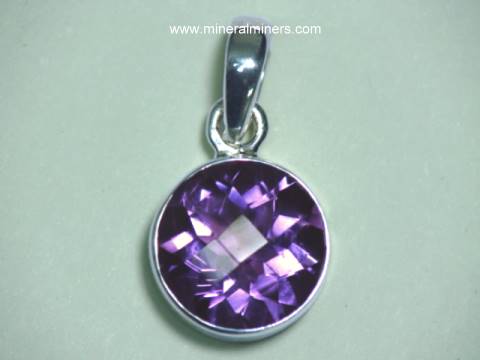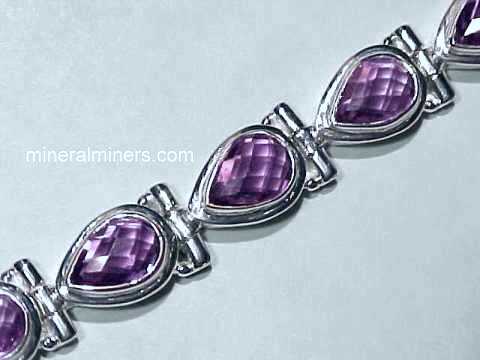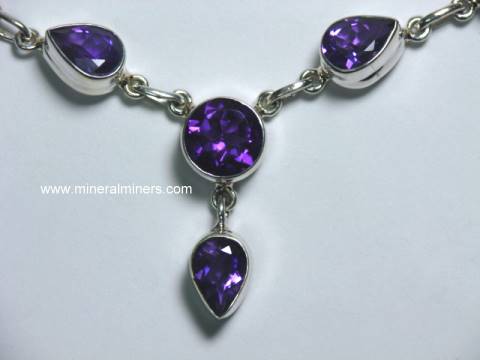


Enter our Virtual Gallery of Amethyst Crystals
MINERALMINERS.COM®- Your Personal 'Link' Direct to the Amethyst Mines!TM



Enter our Virtual Gallery of Amethyst Crystals

Amethyst Information Topics:
See our Amethyst Information Topics Index

Amethyst is a macrocrystalline variety of the mineral Quartz (SiO2). Quartz is the most abundant single mineral on earth. It makes up about 12% of the earth's crust, occurring in a wide variety of igneous, metamorphic and sedimentary rocks.
Quartz varieties are commonly separated into two groups based on the size of the individual grains or crystals; macrocrystalline quartz in which individual crystals are distinguishable with the naked eye, and cryptocrystalline quartz in which the individual crystals are too small to be easily distinguishable under the light microscope.
Some of the macrocrystalline quartz varieties are: Amethyst, Ametrine, Cat's-eye Quartz, Citrine, Phantom Quartz , Rock Crystal, Rose Quartz, Rutilated Quartz, Smoky Quartz and Strawberry Quartz.
Blue Aventurine Quartz (a popular lapidary material for making carvings, sculptures, spheres, unique cabochons gemstones, etc...) and Green Aventurine Quartz are actually quartzites (a rock, not a mineral) composed essentially of interlocking macrocrystalline quartz grains with disseminated grains of other color imparting minerals.
The cryptocrystalline varieties of quartz may be separated into two types;
fibrous and microgranular. Chalcedony is the general term
applied to the fibrous cryptocrystalline varieties.
Agate is an example of a fibrous cryptocystalline
banded chalcedony variety of quartz. Carnelian, Chrysoprase and bloodstone
are other chalcedony varieties.
Chert is the general term applied to the granular cryptocrystalline
varieties of quartz, of which flint and Jasper are examples.
See the Amethyst Information Index
Amethyst has been found in siliceous volcanics, occurring as macroscopic crystals and drusy coverings inside of agate lined amygdaloidal cavities or vugs, often forming geodes. Amethyst also occurs in quartz veins.
The purple color of amethyst is due to small amounts (approximately 40 parts per million) of iron (Fe4+) impurities at specific sites in the crystal structure of quartz. The difference between amethyst and citrine is only the oxidation state of the iron impurities present in the quartz. Upon heating, the iron impurities are reduced and amethyst's purple color fades and becomes yellow to reddish-orange (citrine), green, or colorless depending on the site and original oxidation state of the iron impurities present and the amount and duration of the heating. The amethystine color usually can be regained by irradiation which re-oxidizes the iron impurities. This irradiation can be done by synthetic means, or it can occur in nature by radioactive decay of nearby radioactive minerals. In most cases this is a reversible process, however excessive heating may change the distribution of the iron impurities at the different sites within the quartz making it impossible to convert it back to amethyst by subsequent irradiation. The heating process can occur naturally or synthetically. At the present, it is not possible to determine whether or not an amethyst or citrine was synthetically irradiated or heated.
Amethyst is recognized by its color, crystal habit, occurance, hardness,
glassy luster, conchoidal fracture and lack of cleavage.
See the Amethyst Information Index
Amethyst has been used as gemstones and other ornamental objects for thousands of years.
The early Greeks believed that amethyst would protect one from the effects
of drunkenness when consuming alcohol. A possible explanation for
this unusual virtue being given to amethyst is that when water is poured
into a cup
fashioned of amethyst, it would have the appearance of wine yet could
be drunk without experiencing wine's normal inebriative effect.
In ancient cultures, amethyst amulets were worn as antidotes against poison,
to dispell sleep, as protection against harm in battle and to sharpen one's wits.
In medieval times, amethyst was still credited with protecting one from
the effects of drunkenness, both of the cup and also from the intoxicating
effects of being in love.
The wearing of amethyst was also known to protect
soldiers from harm and give them victory over their enemies, and assist
hunters with the capture of wild animals.
The name amethyst comes from the Greek word amethustos which means not drunken. In the first century, Pliny wrote that amethyst was so named for its color being nearly the same as that of wine. Early Greeks believed that drinking wine from an amethyst cup would prevent intoxication.
The astrological signs of amethyst are Pisces, Virgo,
Aquarius and Capricorn.
Amethyst jewelry is the traditional birthstone gift for the month of February.
Amethyst is the symbolic gemstone for the 17th
wedding anniversary.
See the Amethyst Information Index


Amethyst Crystals are said to bring serenity and calm, to enhance one's ability to assimilate new ideas, and to assist during meditation. Amethyst is also said to give strength and mental stability, and to provide balance between one's physical, emotional, intellectual states. Wearing amethyst jewelry is also said to make one shrewd in business matters.
Amethyst is said to help remove toxins from the body and to help treat arthritus. It also said to be usefull in treating a number of disorders including those of the digestive system, heart, nervous system, skin and hearing and to help provide relief from pain and to strengthen the immune system.
For more in-depth metaphysical information, see our Metaphysical Books section.
See the Amethyst Information Index
See all of our natural quartz varieties:
Go up to the Amethyst Information Index
Last Updated: January 15, 2023